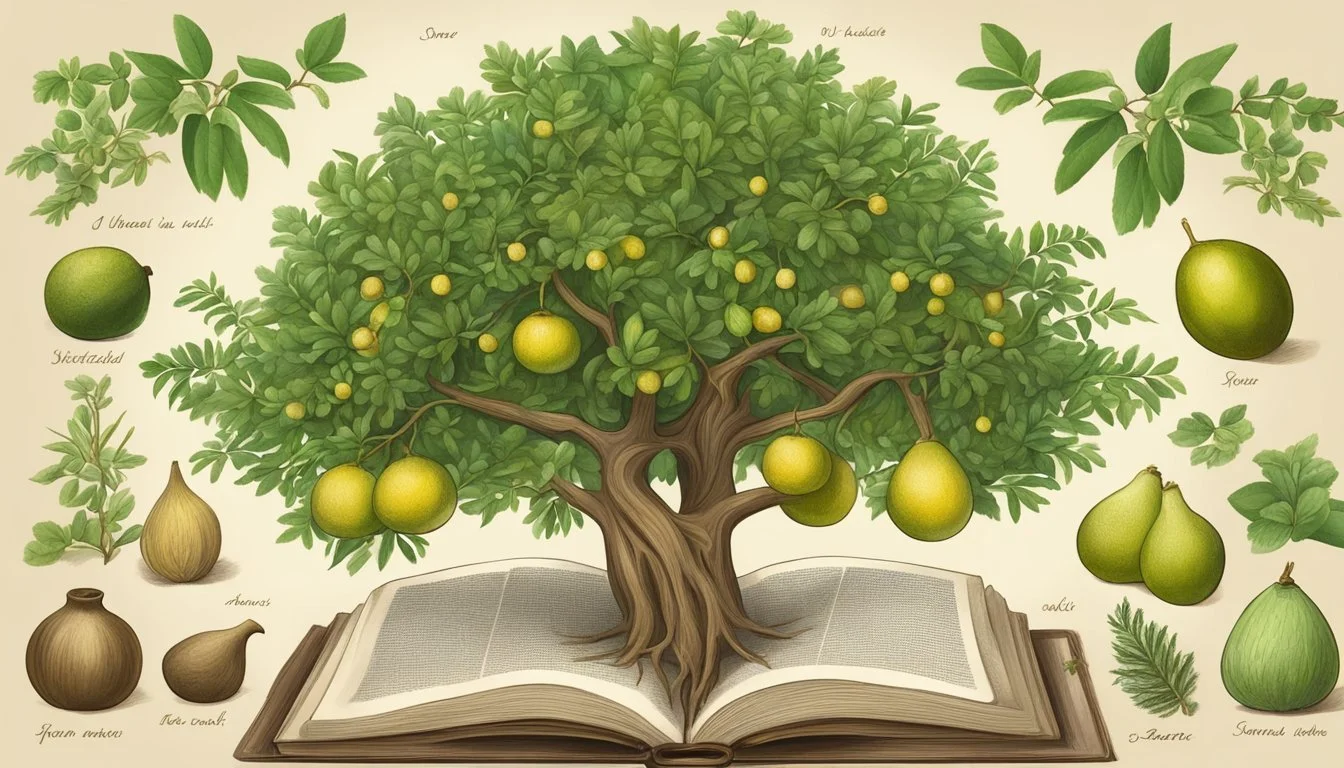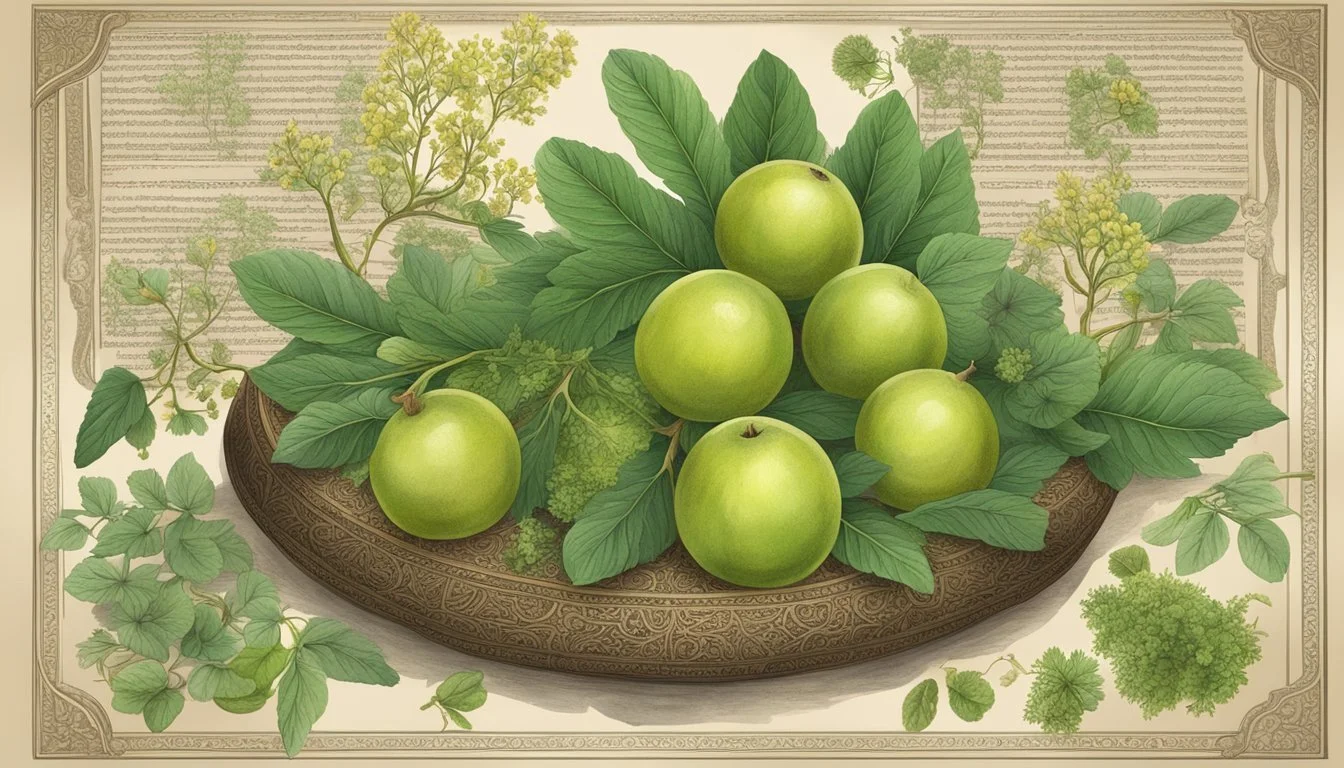The Historical Role of Amla, the Indian Gooseberry, in Ayurvedic Medicine and Wellness Practices
Amla, or Indian gooseberry, figures prominently in Ayurveda's illustrious tapestry of medicinal plants. With its history deeply embedded within the traditional Indian healing system, amla has been used for millennia to promote health and longevity. Ayurvedic texts flamboyantly praise its use for its ability to balance all three doshas (vata, pitta, and kapha), which are elemental energies believed to circulate within the body and govern physiological activity. Its use in ancient practices is well-documented, with a strong emphasis on its restorative and preventive characteristics.
The Indian gooseberry is more than just a fruit; it is regarded as a potent herb that supports a variety of bodily functions. Rich in vitamin C and packed with a barrage of antioxidants, amla is attributed with properties that strengthen the immune system, enhance digestive health, and rejuvenate the body. In the realm of Ayurveda, it has been consistently esteemed for its nourishing and revitalizing effects. The fruit's acclaimed medicinal profile is largely attributed to its high concentration of antioxidants, which combat oxidative stress and aid in protecting the body from various ailments.
Acknowledging the historical significance of amla within Ayurveda leads to a profound appreciation for modern scientific inquiry into this traditional remedy. Contemporary research has started to validate many of the health benefits historically ascribed to the Indian gooseberry, thus reinforcing amla's status as a vital component of traditional Indian medicine. As the bridge between ancient wisdom and modern science continues to strengthen, the role of amla in Ayurveda remains an epitome of a time-tested natural remedy enduring through the ages.
Amla, the Indian Gooseberry, has played a pivotal role in Ayurvedic medicine and wellness practices throughout history. Revered for its potent health-boosting properties, Amla has been a cornerstone of traditional Indian medicine for centuries. When combined with mullein, astragalus, and yerba mate, Amla offers a holistic approach to supporting overall well-being, reflecting the depth of its historical significance in promoting vitality.
Furthermore, the addition of olive oil, cardamom, and ashwagandha further complements the health-enhancing potential of Amla, contributing to its reputation as a versatile and effective natural remedy. Additionally, the incorporation of sea buckthorn into wellness practices alongside Amla has expanded the spectrum of potential health benefits, underscoring the enduring appeal of this Indian superfruit.
In conclusion, Amla, the Indian Gooseberry, continues to be celebrated for its historical and contemporary role in Ayurvedic medicine and wellness practices. Whether combined with mullein, astragalus, yerba mate, olive oil, cardamom, ashwagandha, or sea buckthorn, Amla remains a symbol of vitality and holistic well-being, embodying the rich heritage of Indian traditional medicine.
Amla in Ayurvedic Tradition
Amla, the Indian gooseberry (Emblica officinalis), holds a distinguished place in Ayurveda due to its multifaceted therapeutic properties and alignment with doshic balance.
Origins and Sanskrit Significance
The Sanskrit name for Indian gooseberry, Amalaki, resonates with its endemic roots in India. Historical texts and Ayurvedic scholars have long celebrated this fruit for its health-promoting qualities. In Sanskrit literature, Amla is often associated with the term "rasayana," denoting its role in promoting longevity and rejuvenation.
Incorporation into Ayurvedic Medicine
Indian gooseberry's incorporation into Ayurvedic medicine is multifaceted. It is one of the three constituents of the traditional herbal formulation, Triphala, where it contributes to the synergistic healing effect. Amla contains a high concentration of natural antioxidants and vitamin C, which validates its rich medicinal applications – from supporting digestion to enhancing immunity.
Ayurvedic Applications of Amla Description Digestive Health Amla is said to aid in balancing stomach acids, fostering digestive health. Immune Support Its high vitamin C content is believed to bolster the immune system. Hair and Skin Care Amla's antioxidants are harnessed for nourishing hair and skin. Overall Well-being It is considered a potent adaptogen, helping the body resist stressors.
The Concept of Doshas
In the realm of Ayurveda, the concept of doshas – Vata, Pitta, and Kapha – signifies the energies that govern physiological activity. Amla is renowned for its ability to balance all three doshas, as it possesses the five out of six tastes (sweet, sour, bitter, pungent, and astringent) excluding salty. Therefore, Amla is particularly esteemed in Ayurvedic tradition for its holistic approach to health. It caters to the rasa (taste) that influences doshas, harmoniously restoring the body's natural state of equilibrium.
Amla's Nutritional Profile
Amla, also known as Indian gooseberry, is renowned for its remarkable nutritional density, which includes a significant concentration of vitamin C, a range of minerals and amino acids, a diverse array of antioxidants, and an impressive spectrum of phenolic compounds.
Vitamin C Richness
Amla is an extraordinary source of vitamin C, with the Indian gooseberry containing up to 20 times as much vitamin C as an orange. Each amla berry can contain from 600 to 700 mg of vitamin C, which is a potent antioxidant also referred to as ascorbic acid. This high concentration of vitamin C bolsters the immune system and aids in the synthesis of collagen.
Minerals and Amino Acids
In addition to its vitamin C content, amla provides a variety of essential minerals such as:
Calcium
Phosphorus
Iron
Magnesium
Potassium
Furthermore, Indian gooseberry encompasses numerous amino acids, which are the building blocks of protein, contributing to muscle building, cell growth, and repair.
Diversity of Antioxidants
Amla is abundant in antioxidants beyond vitamin C. These antioxidants play a critical role in combating oxidative stress and protecting the body's cells from damage. The berry's antioxidant profile includes:
Flavonoids
Kaempferol
Ellagic acid
Gallic acid
Phenolic Compounds of Amla
Phenolic compounds are another noteworthy component of amla's nutritional makeup. These compounds, particularly tannins like emblicanin A and B, have been studied for their health-benefiting properties. Amla is also a good source of dietary fiber, which aids in digestion and may contribute to heart health.
Health Benefits Associated with Amla
Amla, or the Indian Gooseberry, has been esteemed in Ayurveda for its multifaceted health benefits ranging from digestive health support to potent antioxidative properties. This section explores the diverse therapeutic roles attributed to Amla.
Promotion of Digestive Health
Amla is recognized for aiding digestion due to its high fiber content. It stimulates gastric juice production, improving digestive enzyme activity, and alleviating problems such as constipation.
Blood Sugar and Diabetes Management
The fruit exhibits antidiabetic properties, making it beneficial for blood sugar regulation. Compounds found in Amla help manage diabetes by promoting insulin sensitivity.
Boosting Immune System
Amla's immunomodulatory effects strengthen the immune response. Its rich antioxidant content, including vitamin C, enhances overall immunity and wards off infections.
Skin and Hair Health Enhancement
Rich in nutrients and antibacterial properties, Amla improves skin health and contributes to hair growth. It aids in producing collagen and strengthens hair roots for better hair health.
Cardiovascular Wellness
Amla contributes to cardiovascular health by regulating cholesterol levels, one of the contributing factors to heart disease. It exerts a protective role, keeping cholesterol in check.
Anti-inflammatory and Anticancer Properties
Its anti-inflammatory and anticancer abilities, attributed to its chemopreventive nature, help in the prevention and potential treatment of cancer and inflammatory conditions.
Liver Protection and Detoxification
The Indian Gooseberry offers hepatoprotective benefits, safeguarding the liver from oxidative stress and aiding in liver disease management and detoxification.
Cognitive Benefits and Mental Well-being
Consumption of Amla is linked to enhanced memory and concentration, courtesy of its neuroprotective agents. It supports mental performance and cognitive longevity.
Amla in Different Ayurvedic Preparations
Amla, the Indian Gooseberry, is central to many Ayurvedic preparations, playing a crucial role in enhancing the efficacy and nutritional value of these formulations.
Ayurvedic Formulations Featuring Amla
In the vast pharmacopoeia of Ayurvedic medicine, Amla is incorporated into numerous herbal formulations. Its high vitamin C content and potent antioxidant properties make it a widely used herb. Notably, Amla is utilized in Rasayana therapy, which aims to rejuvenate the body. Due to its versatility, it is mixed with other medicinal plants to create a variety of health supplements and medicinal concoctions. For example, amla is commonly combined with cardamom and cinnamon to enhance digestion and promote internal cleansing.
Usage in Triphala
Triphala, a cornerstone in Ayurvedic practice, prominently includes Amla as one of its three fruits, the others being Bibhitaki and Haritaki. This herbal compound is revered for its balancing effect on the three doshas—Vata, Pitta, and Kapha.
Amla (Emblica officinalis): Detoxifies and rejuvenates the digestive tract.
Bibhitaki (Terminalia bellirica): Detoxifies and supports respiratory health.
Haritaki (Terminalia chebula): Promotes digestion and absorption.
A typical Triphala blend might look like this:
Ingredient Percentage Amla 33.3% Bibhitaki 33.3% Haritaki 33.3%
Triphala is traditionally taken with water, honey, or milk and is known for its synergistic and gentle effects on the body.
The Making of Chyawanprash
Chyawanprash is an Ayurvedic tonic that is created with Amla as its core ingredient, harmonized with a unique blend of over forty herbs, spices, and nutritional substances. It is designed as a rasayana, beneficial for all ages to bolster immunity and vitality.
Some common components of Chyawanprash include:
Amla: Serves as the base, providing antioxidants and vitamin C.
Honey: Added for its preservative and flavor-enhancing properties.
Ghee: Acts as a carrier for the therapeutic properties of herbs.
The preparation of Chyawanprash is an elaborate process that involves cooking the herbal mixture into a jam-like consistency. This concoction is then utilized as a daily health supplement to provide a wide range of health benefits, with a strong emphasis on respiratory and immune health.
Other Traditional Medicinal Systems
While the Indian Ayurvedic system is renowned for its extensive use of Amla, the Indian gooseberry is also an integral component in other traditional medicinal systems such as Unani and Siddha practices. These systems, with their unique methodologies, recognize the potency of Amla in promoting health and treating ailments.
Amla in Unani Medicine
In the Unani system of medicine, which originated in Greece and was developed further by Arab and Persian physicians, Amla (Phyllanthus emblica) holds a significant place. It is classified under drugs that correct the body's humors, primarily used to balance sauda (black bile). Traditional uses of Amla in Unani involve its employment as a musaffi-e-khoon (blood purifier) and its effectiveness in treating diseases related to an imbalance of sauda such as melancholia and certain skin conditions.
The Unani system also employs Amla for its ethnomedicinal uses, taking advantage of its high vitamin content and antioxidant properties to strengthen the body's vital organs and immune system.
The Role of Amla in Siddha Practice
Siddha medicine, originating in South India, incorporates Amla as a fundamental herb in its pharmacopeia. Referred to as 'Nellikkai' in Siddha, this fruit is considered a master rejuvenator. It is often prescribed for its cooling properties to treat pitta aggravations.
The traditional uses of Amla in Siddha medicine include enhancing digestive health, fortifying liver function, and improving hair growth. Similar to Ayurveda and Unani, Siddha also values Amla for its rich vitamin C content, leveraging it as a natural antioxidant in various compounds. Siddha practitioners commonly utilize Amla in its fresh form, dried, or as a processed oil for both internal and external applications.
Cultural and Ethnobotanical Aspects
The Indian gooseberry, also known as amla or by its scientific names Phyllanthus emblica and Emblica officinalis, holds substantial cultural significance and a breadth of uses in various traditional medicines around the globe. This section will explore its deep-rooted place in Indian culture and its diverse ethnobotanical applications.
Amla's Place in Indian Culture
In India, the amla tree, referred to as dhatri in Sanskrit, symbolizing the 'nurse' or 'mother', is revered for its nurturing and healing abilities. It is a central element in Ayurveda, the ancient Indian system of medicine. Amla is celebrated in Hindu mythology and texts as a sacred fruit, and its use is deeply interwoven with religious rites and culinary traditions. The tree is often found near temples, and its fruit is used in rituals. In Hindi culture, amla is linked with prosperity and considered a protector against evil influences.
Global Ethnobotanical Uses
Beyond Indian borders, Phyllanthus emblica has been recognized for its ethnomedicinal uses in different parts of Asia, such as China and Southeast Asia. Traditional healers and local communities have utilized various parts of the amla tree for their medicinal properties. Its fruit, rich in vitamin C, is known for promoting longevity and enhancing digestion, while the tree's bark, leaves, and seeds are incorporated into remedies for ailments such as fever and diabetes. The global appreciation for amla underscores its versatile role in traditional healthcare systems.
Nutritional Constituents: Rich source of Vitamin C, antioxidants, and polyphenols
Therapeutic Uses: Includes improving vision, strengthening hair roots, and aiding digestion
Scientific Research and Future Perspectives
In recent years, scientific research has begun to demystify the components of amla and explore its potential in modern medicine, specifically in chronic conditions like diabetes and cancer, through its antioxidative properties.
Modern Phytochemistry of Amla
The Phyllanthus emblica, commonly known as amla, has been analyzed for its phytochemistry revealing a high concentration of vitamin C, along with a plethora of bioactive compounds including tannoids and flavonoids. These components contribute to its potent antioxidant profile, which combats oxidative stress by neutralizing free radicals such as superoxide and hydroxyl.
Ongoing Studies on Amla's Medicinal Properties
Studies have been focusing on amla’s anti-inflammatory effects and its mechanisms in disease modulation. It has shown promise in managing diabetes by improving glucose metabolism and in the prevention of cancer through its ability to impede the proliferation of malignant cells. In addition to its role in countering reactive oxygen species, ongoing research explores its therapeutic synergy with conventional treatments like chemotherapy and radiotherapy.
Amla's Role in Emerging Therapies
The future perspectives for amla in therapeutic applications are broadening. Research is examining its integrative use in chemo and radio protective protocols to mitigate the harmful side effects of such treatments. The antioxidative stress capabilities of amla lay the foundation for its potential inclusion in new, more targeted approaches to medicine.









